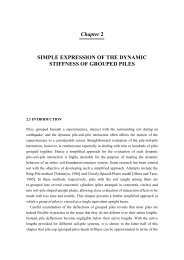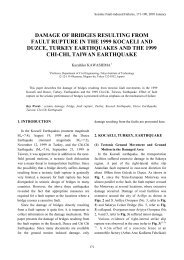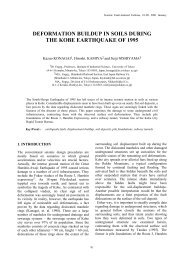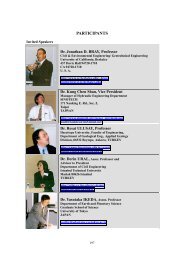Damage to ShihKang Dam Inflicted by Faulting in the Sept. 1999 Chi ...
Damage to ShihKang Dam Inflicted by Faulting in the Sept. 1999 Chi ...
Damage to ShihKang Dam Inflicted by Faulting in the Sept. 1999 Chi ...
Create successful ePaper yourself
Turn your PDF publications into a flip-book with our unique Google optimized e-Paper software.
Fig. 11<br />
Chelungpu fault<br />
Figure 1 Tec<strong>to</strong>nic Structure around Taiwan<br />
(after Seno, <strong>1999</strong>)<br />
<br />
Figure 3 Faults <strong>in</strong> Taiwan<br />
(Central Geological Survey, 1998)<br />
<br />
Figure 2 Plate tec<strong>to</strong>nic of Taiwan<br />
(after Seno, <strong>1999</strong>)<br />
longitud<strong>in</strong>al north-south direction. The island is<br />
located right upon <strong>the</strong> wedge of <strong>the</strong> Philipp<strong>in</strong>e Sea<br />
(PS) plate, <strong>the</strong> wedge cutt<strong>in</strong>g deep <strong>in</strong><strong>to</strong> <strong>the</strong> Eurasian<br />
(EU) plate. The nor<strong>the</strong>rn side of <strong>the</strong> wedge subducts<br />
along <strong>the</strong> Ryukyu Trench beneath <strong>the</strong> EU plate,<br />
while <strong>the</strong> southwestern side of <strong>the</strong> wedge overrides<br />
<strong>the</strong> EU plate (Fig. 1). The collision of <strong>the</strong> two plates<br />
has led <strong>to</strong> <strong>the</strong> formation of <strong>the</strong> backbone ridge of <strong>the</strong><br />
island exceed<strong>in</strong>g 3000m elevation with a number of<br />
faults. The activated fault runs along <strong>the</strong> western<br />
edge of <strong>the</strong> accretionary prism accumulated along<br />
<strong>the</strong> subduction zone boundary (decollement) as<br />
illustrated <strong>in</strong> Figure 2 (after T. Seno, <strong>1999</strong>). The<br />
earthquake <strong>the</strong>refore may be categorized as a<br />
subduction zone earthquake. Figure 3 is taken from<br />
“An Introduction <strong>to</strong> <strong>the</strong> Active Faults of Taiwan”,<br />
Central Geological Survey (CGS), M<strong>in</strong>istry of<br />
Economic Affairs, Taiwan. The CGS has confirmed<br />
that 51 active and/or suspicious faults longer than 5<br />
km exist, and are classified as follows:<br />
(1) 1 st category active faults (9):<br />
a) activated at least once <strong>in</strong> <strong>the</strong> past 10,000 years,<br />
b) hav<strong>in</strong>g caused some damage <strong>to</strong> exist<strong>in</strong>g<br />
structures,<br />
c) responsible for earthquake occurrences,<br />
d) hav<strong>in</strong>g deformed alluvial soil deposits, and<br />
e) whose presences are clearly recognized from<br />
surface geological configurations.<br />
(2) 2 nd category active faults (15):<br />
a) activated at least once <strong>in</strong> <strong>the</strong> past 10,000 years,<br />
and<br />
b) hav<strong>in</strong>g deformed diluvial terraces.<br />
(3) Suspects (27):<br />
a) with ambiguous features <strong>in</strong> Quaternary<br />
configurations,<br />
b) with ambiguous features <strong>in</strong> laterite soils, and<br />
c) look<strong>in</strong>g alike but without any clear evidences.<br />
The earthquake, with a magnitude of 7.3 (Central<br />
Wea<strong>the</strong>r Bureau, CWB) <strong>to</strong>ok place at 1:47 AM,<br />
local time on 21, <strong>Sept</strong>., <strong>1999</strong>. The epicenter was<br />
located at latitude 23.85°N and longitude 120.81°E.<br />
Figure 4 shows <strong>the</strong> ma<strong>in</strong> shock and aftershocks.<br />
The earthquake that orig<strong>in</strong>ated at a shallow focal<br />
depth of 6.99 km produced spectacular reverse<br />
fault<strong>in</strong>g. The activated fault seems <strong>to</strong> have appeared<br />
exactly along <strong>the</strong> Chelungpu Fault, whose presence<br />
had been already recognized and classified <strong>in</strong><strong>to</strong> <strong>the</strong><br />
2 nd category of active faults. Hence, <strong>the</strong> activated<br />
fault, <strong>in</strong> this chapter hereafter, will be referred <strong>to</strong> as<br />
<strong>the</strong> Chelungpu Fault. The activated fault, however,<br />
144






